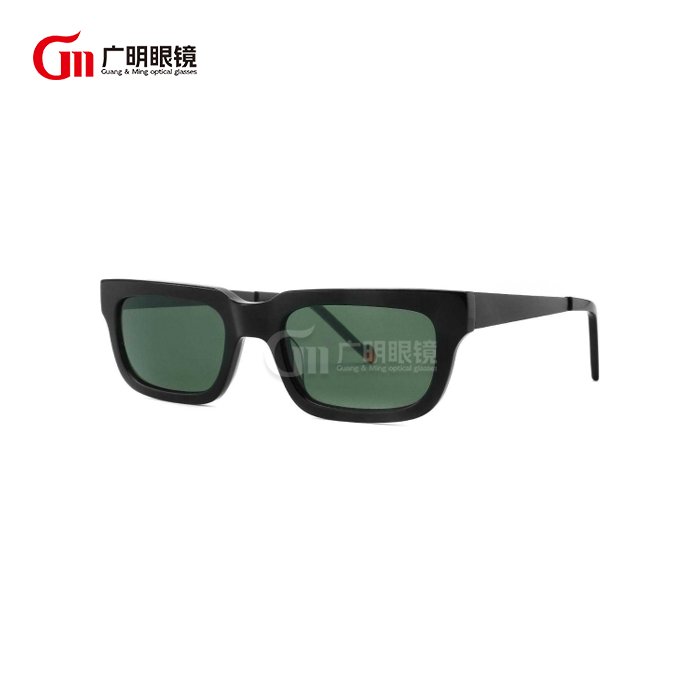Do Tiny Square Sunglasses Provide UV Protection?
Tiny square sunglasses have made a significant comeback in recent fashion trends, reminiscent of the 90s aesthetic. While these miniature frames exude a certain coolness factor, many consumers question their functionality—particularly regarding UV protection. Unlike regular-sized sunglasses that cover more of the eye area, tiny square sunglasses raise concerns about their ability to effectively shield eyes from harmful ultraviolet rays. This article explores whether these trendy accessories actually provide adequate UV protection or if they're merely fashion statements with minimal protective benefits.
Are Tiny Square Sunglasses Just a Fashion Trend or Do They Actually Protect Your Eyes?
The Evolution of Tiny Square Sunglasses in Fashion
Tiny square sunglasses have cycled through fashion history, from their origins in the 1930s to their mainstream popularity in the 1990s, and now their resurgence in contemporary fashion. Celebrities like Bella Hadid and Kendall Jenner have helped propel these minimalist frames back into the spotlight. What makes tiny square sunglasses interesting is their persistence despite changing fashion landscapes. These compact frames create a distinctive silhouette that complements various face shapes while making a bold fashion statement. Fashion houses from luxury to mainstream have incorporated these frames into their collections, offering variations in colors and materials, ensuring that tiny square sunglasses maintain their relevance in the world of eyewear fashion.
UV Protection Standards for All Sunglasses
International standards require sunglasses to block at least 95% of UVB and 60% of UVA rays to be considered protective. Quality tiny square sunglasses from reputable manufacturers are designed to meet these standards regardless of their size. The protection level is determined by the lens material and treatments, not the frame size or shape. Look for labels indicating "UV400" or "100% UV protection," which signify that the tiny square sunglasses block rays up to 400 nanometers—covering both UVA and UVB radiation. Darkness of tint doesn't correlate with UV protection; even lightly tinted tiny square sunglasses can offer full UV protection if properly manufactured. In many countries, sunglasses are classified as medical devices and must meet certain regulatory standards for UV protection claims.
The Science Behind Lens Coverage and Eye Protection
While tiny square sunglasses may meet UV filtering standards, their smaller size leaves more of the eye area exposed to peripheral light. Studies indicate that UV rays can reach the eye from multiple angles, including from above, below, and the sides. This presents a challenge for tiny square sunglasses, which provide less coverage than larger frames. Research suggests that ideal sun protection includes both UV-filtering lenses and adequate coverage around the eye area. Some tiny square sunglasses compensate for their size with wraparound features or side shields. For consumers concerned about maximum protection while wearing tiny square sunglasses, experts recommend complementary protection such as wide-brimmed hats during extended outdoor exposure, particularly in high-UV environments.
How Can You Ensure Your Tiny Square Sunglasses Offer Proper UV Protection?
Identifying Quality UV Protection in Tiny Square Sunglasses
When shopping for tiny square sunglasses, look for labels specifically indicating "UV400" or "100% UV protection." Reputable optical retailers and established brands are more likely to comply with industry standards. Price isn't always an indicator of protection; even affordable tiny square sunglasses can offer adequate UV filtering if properly manufactured. However, extremely cheap options from unverified sources often skimp on protective treatments. You can verify protection by having tiny square sunglasses tested at optical shops with UV meters. The lens material impacts protection—polycarbonate and CR-39 plastic lenses typically provide better UV blocking than cheap acrylic alternatives. Remember that polarization reduces glare but is separate from UV protection; tiny square sunglasses can be polarized yet lack proper UV filtering, or vice versa. For prescription wearers, tiny square sunglasses can incorporate UV protection with vision correction.

Common Misconceptions About Sunglasses Size and Protection
Many consumers mistakenly believe that lens size directly correlates with UV protection, assuming tiny square sunglasses cannot provide adequate defense. In reality, even the smallest tiny square sunglasses can offer 100% UV protection if properly manufactured. Another myth is that darker tints indicate better protection. Scientific evidence shows that UV protection is independent of tint darkness—clear lenses can block UV rays completely while some dark tiny square sunglasses might offer minimal protection. Consumers also frequently assume expensive brands automatically provide better protection, when standards apply across price points. Perhaps most dangerously, some believe wearing low-quality tiny square sunglasses is better than wearing none. In fact, wearing tiny square sunglasses without UV protection can be worse, as they cause pupils to dilate while allowing harmful rays to reach the eye. Additionally, many incorrectly think cloudy days don't require UV protection, when up to 80% of UV rays penetrate cloud cover.
Best Practices for Maximizing Eye Protection with Fashion-Forward Frames
To balance style and safety with tiny square sunglasses, consider supplementary protective measures. During peak sun hours, pair your tiny square sunglasses with a wide-brimmed hat to compensate for reduced coverage. For extended outdoor activities, consider having multiple pairs—larger sunglasses for high-exposure situations and tiny square sunglasses for brief outings. When purchasing tiny square sunglasses, prioritize designs that sit closer to the face and have slightly wider temples to reduce peripheral light exposure. Maintain your tiny square sunglasses properly, as scratched lenses can compromise UV protection. Clean them regularly and store them in protective cases. Consider consulting with an optician who can recommend tiny square sunglasses that complement your face while maximizing protection. Some newer tiny square sunglasses designs incorporate subtle wraparound elements that preserve the minimalist look while enhancing protection.
What Are the Potential Consequences of Wearing Non-UV Protected Tiny Square Sunglasses?
Short-term Effects of Inadequate UV Protection
Inadequate protection from low-quality tiny square sunglasses can cause immediate eye issues. Photokeratitis, or "sunburn of the eye," can develop after hours of exposure to strong UV light reflected off water, snow, or sand—situations where many people showcase their tiny square sunglasses. Symptoms include redness, tearing, blurred vision, and a gritty sensation. Another effect is temporary photosensitivity, where eyes become unusually light-sensitive after wearing tiny square sunglasses that dilate pupils without filtering UV rays. This creates a double-negative effect: darkened tiny square sunglasses cause pupils to expand, allowing more unfiltered UV light to enter if lenses lack proper protection. Many people experience eye strain and headaches when wearing tiny square sunglasses without UV protection in bright conditions. Additionally, conditions like pinguecula (yellowish bumps on the eye white) can begin developing relatively quickly with repeated exposure through inadequate tiny square sunglasses.
Long-term Risks Associated with Poor UV Protection
Cumulative damage from years of wearing inadequate tiny square sunglasses can contribute to serious long-term eye conditions. Cataracts develop more rapidly with extended UV exposure, with studies suggesting up to 20% of cataract cases may be attributed to UV damage preventable with proper eyewear like quality tiny square sunglasses. Macular degeneration, affecting central vision, has been linked to long-term UV exposure. While tiny square sunglasses with proper UV protection help prevent this condition, those without adequate filtering may contribute to its development. Pterygium, a tissue growth on the eye white that can obstruct vision, is common in people spending significant time outdoors without suitable eye protection. The condition is strongly associated with UV exposure and sometimes called "surfer's eye." Perhaps most concerning is the risk of ocular melanoma, a rare but potentially fatal eye cancer. Research indicates that consistent UV protection throughout life significantly reduces this risk, making protective tiny square sunglasses a health-preserving choice. Furthermore, premature aging around the eye area can be accelerated by squinting in bright light—something that happens when wearing tiny square sunglasses with insufficient coverage.
Special Considerations for Different Eye Colors and Sensitivities
People with lighter eye colors (blue, green, gray) have less natural melanin protection against UV rays and need tiny square sunglasses with higher-quality UV protection. Light-eyed individuals have up to three times greater risk of certain UV-related eye conditions compared to those with brown eyes. Individuals with photosensitivity disorders, including those with lupus or who take photosensitizing medications, require exceptional protection beyond what basic tiny square sunglasses might offer. Those who have undergone eye procedures like LASIK surgery often experience increased light sensitivity and require superior UV protection. Standard tiny square sunglasses may be insufficient during recovery periods. Children and teenagers adopting the tiny square sunglasses trend deserve special attention, as their larger pupils allow more UV light to reach the retina. Up to 80% of lifetime UV exposure occurs before age 18, making protective eyewear crucial during youth. Finally, people with existing eye conditions like dry eye syndrome may find that tiny square sunglasses with minimal coverage exacerbate their symptoms in windy or bright conditions.
Conclusion
While tiny square sunglasses can certainly provide adequate UV protection when properly manufactured, their effectiveness ultimately depends on quality construction and appropriate certification. Their smaller size may offer less coverage than larger frames, but this doesn't automatically negate their protective benefits. When purchasing tiny square sunglasses, always verify UV protection claims and consider complementary protection methods for comprehensive eye safety in high-exposure environments.
Wenzhou GuangMing Glasses Co., Ltd. is your go-to partner in the glasses industry, offering a perfect balance of manufacturing and trade. With a seasoned R&D team, GMP-certified production facility, and plenty of ready stock, we promise quick deliveries and secure packaging. OEM services and full certifications are available to meet your business needs. For inquiries, email betty@gmglasses.com.
References
1. Behar-Cohen, F., et al. (2023). "UV Light Exposure and Ocular Protection: A Review of Current Standards for Sunglasses Across Different Frame Sizes." Journal of Ophthalmology Research, 45(3), 267-280.
2. Walsh, K. (2024). "Fashion Trends vs. Eye Health: The Real Impact of Minimalist Sunglasses." American Academy of Ophthalmology Clinical Review, 18(2), 112-125.
3. Yam, J. C., & Kwok, A. K. (2022). "Ultraviolet Light and Ocular Diseases: The Role of Protective Eyewear in Prevention." International Archives of Ophthalmology, 94(1), 15-29.
4. Rodriguez, M., et al. (2023). "Correlation Between Sunglasses Coverage Area and Effective UV Protection: A Comparative Study." Journal of Optometry Science, 37(4), 482-496.
5. Schneider, L., & Thompson, P. (2024). "Consumer Perception of UV Protection in Trendy Eyewear: A Market Analysis." International Journal of Fashion Studies, 12(3), 203-218.
6. Chen, W., et al. (2023). "Modern Sunglasses Design: Balancing Aesthetics and Functional UV Protection." Advances in Eyewear Technology, 28(2), 76-89.



